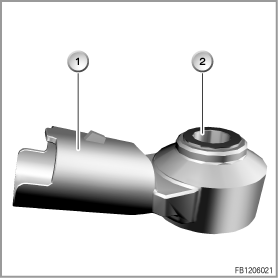
The knock control monitors the combustion process. The functions of the knock control have been extended. The DME control unit also detects super-knocking (special form of spontaneous ignition).
The following components are described for the knock control:
The knock sensor detects the combustion knock. The knocking is detected on a cylinder-selective basis by the DME control unit.

Index |
Explanation |
Index |
Explanation |
|---|---|---|---|
1 |
2-pin plug-in connection |
2 |
Knock sensor |
In contrast to normal combustion, knocking combustion involves auto-ignition in the still uncombusted mixture towards the end of combustion. Operation of an engine with knocking combustion over a prolonged period can lead to serious damage.
Knocking tendency is increased by:
On engines without knock control, these unfavourable influences must be taken into consideration in the ignition design by providing a safety distance to the knock limit. However, this results in unavoidable losses in efficiency in the upper load range.
The following system functions are described for the knock control:
The knock control prevents knock. It retards the ignition timing of the affected cylinder(s) (cylinder-selective) only as far as necessary and only if there is an actual risk of knocking. In this way, the ignition angle characteristic map can be adapted to the optimum consumption values (without having to take the knock limit into consideration). A safety distance is no longer necessary. The knock control system carries out all knock-related corrections to the ignition timing and enables perfect operation also with regular grade fuel (minimum RON 91).
The knock control provides:
Self-diagnosis of the knock control system includes the following checks:
The knock control system is switched off if a fault is found during the course of one of these checks. The emergency program adopts the task of controlling the ignition timing. At the same time, the relevant fault is entered in the DME fault code memory. The emergency program ensures damage-free operation as from minimum RON 91. It depends on the engine load, speed and engine temperature.
Spontaneous ignition is an unwanted ignition. The mixture is ignited by glowing parts in the combustion chamber before the electrical ignition. Spontaneous ignition can occur on engine with direct fuel injection.
Super-knocking is irregular combustion that occurs on highly turbocharged engines. Here, the maximum combustion pressure of approx. 100 bar rises to up to 200 bar. The causes of this are impurities in the combustion chamber (oil, residual gas, carbon particles) that trigger inflammation of the mixture before the actual point of ignition. This is why super-knocking cannot be eliminated by means of ignition interventions.
If the DME detects super-knocking, the power output is reduced to protect against engine damage. Brief super-knocking is caused by individual dirt particles. Super-knocking leads to short-term shutdown of the fuel injection (3 to 6 cycles) at the cylinder concerned. A fault is also entered in the fault code memory.
No liability can be accepted for printing or other errors. Subject to changes of a technical nature